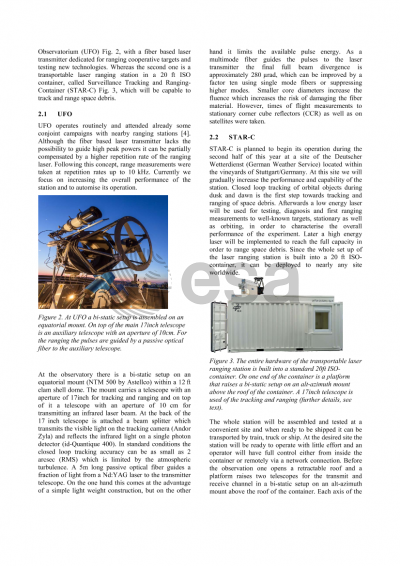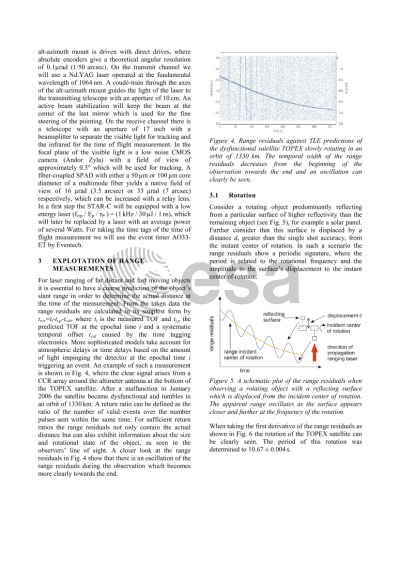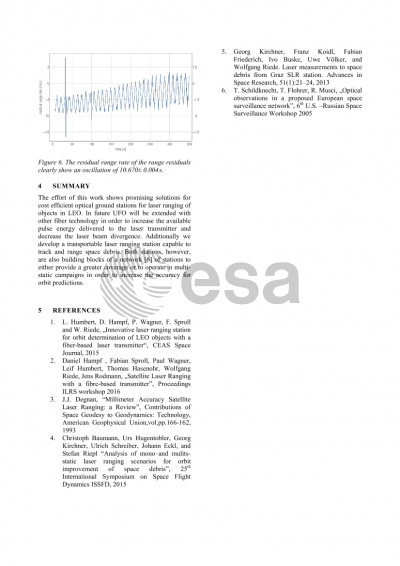Document details

Abstract
Innovative Technologies for Optical Ground Stations
Leif Humbert, Daniel Hampf, Fabian Sproll, Paul Wagner, Thomas Hasenohr, Jens Rodmann, Wolfgang Riede
German Aerospace Center, Institute of Technical Physics, Pfaffenwaldring 38-40, 70569 Stuttgart, Germany
Mega constellations will be operational within a few years and will increase tenfold the current number of active satellites. Each constellation will contain hundreds to thousands satellites typically in orbits from 1100km to 1400km. In order maintain a mega constellation, multiple satellites are launched while other are actively lowered after a service time of 5-7 years. The installation and replacement of satellites is a challenging problem for space traffic management, space situational awareness and a potential threat for orbits becoming unfeasible for thousands of years. The major concern here is the generation of space debris from collisions among the satellites, break ups of the satellites or collisions with already existing space debris, which will add to the already existing population of space debris objects.
At the Institute of Physics at the German Aerospace Center new technologies are developed and investigated for the detection and ranging of space debris with optical ground stations. In contrast to well-known orbits of satellites, which are routinely tracked by stations within the ILRS network, the orbits of space debris given by their TLE data from the NORAD catalogue are inaccurate and deviate up to kilometres in each direction. This inaccuracy is insufficient for precise orbit determination and hence collisional warnings. However, at our ground station Uhlandshöhe-Forschungsobservatorium (UFO) we successfully demonstrated a tracking algorithm with an uncertainty of 2arcsec using TLE data for coarse guidance and the solar reflection for tracking. While tracking an object in LEO, we can also determine the slant range with a time of flight (ToF) measurement using the fundamental line at 1064nm of a pulsed Nd:YAG laser at repetition rates up to 5kHz. Instead of guiding the light along a Coudé path, the most common approach, we chose the unconventional approach to guide the light from the source to the transmitter via a passive fiber. The emitted pulse energy is as high as 20µJ with a full beam divergence of 80 arcsec/ 400µrad, which leaves room for further improvements, but cooperative targets in orbits of 6000km like LAGEOS II were successfully tracked and ranged. This allows upgrading already existing optical ground stations with a cost efficient laser ranging system, since all components are commercially available.
A new laser station is currently under construction to deliver higher pulse energy along a Coudé path and to deliver a concept for a fast deployable laser ranging station as a building block of a network of laser ranging stations. Each station is built into a standard 20ft ISO container containing a 17inch telescope on an agile mount with an encoder resolution of 26bit In addition each station is equipped with a stare and chase system for detecting unknown objects down to a size of 30cm in LEO. The entire station can be remotely controlled by our proprietary software, such that an operator can run campaigns like bi-static campaigns with two of our own stations independently of any preliminary information from a catalogue, support flight manoeuvres and to support the improvement of orbital elements in a catalogue.
Preview





